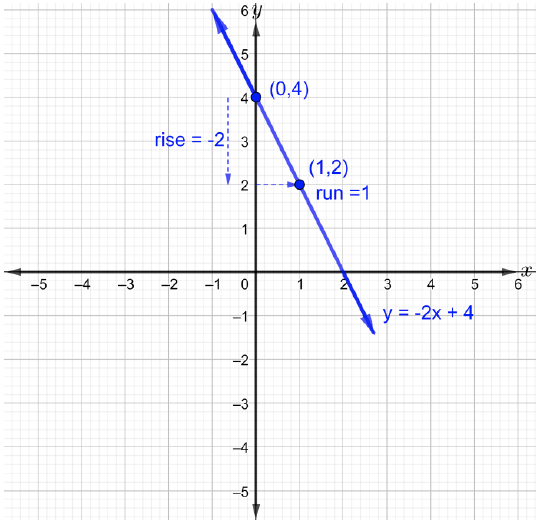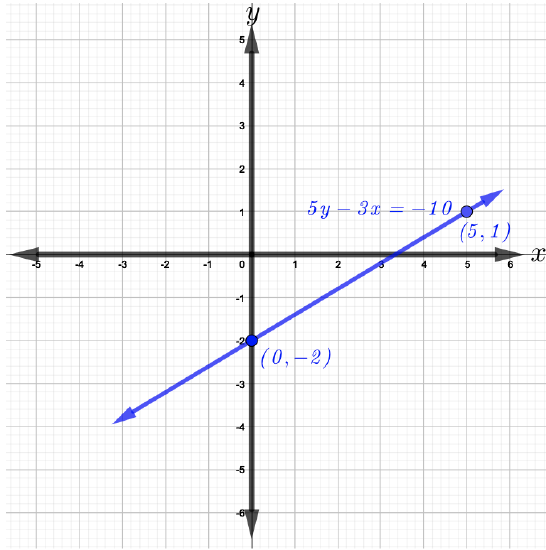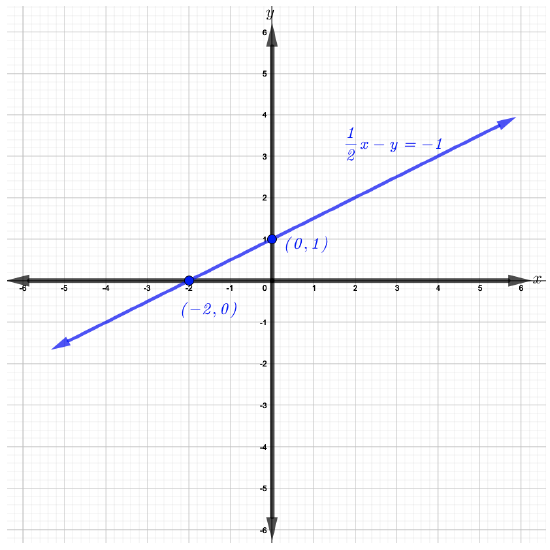7.5: Forms of the Equation of a Line
( \newcommand{\kernel}{\mathrm{null}\,}\)
The previous section explained the equations of vertical and horizontal lines. Now discover three more forms of the equations of a line, namely, the Slope-Intercept Form, the Point-Slope Form, and the Standard Form.
Slope-Intercept Form of the Equation of a Line
The Slope-Intercept Form of the equation of a line is of the form:
y=mx+b
Where m is the slope of the line and (0,b) is the y−intercept.
Note that the y-intercept is the point where the line intersect the y−axis, that is when x=0.
Write an equation of the line with the given slopes and y-intercepts.
- slope = 5; y−intercept (0,12)
- slope = −56; y− intercept (0,−34)
Solution
- m=5 and b=12
The equation of a line is of the for y=mx+b. Thus,
y=mx+bSlope-intercept form=5x+12Substitute m=5 and b=12
Therefore, y=5x+12 is the equation of the line with the given slope and y-intercept.
- Given m=−56 and b=−34
Thus,
y=mx+bSlope-intercept form=−56x−34Substitute values
Therefore, y=−56x−34 is the equation of the line with the given slope and y-intercept.
Identify the slope and y−intercept then, use them to graph each line.
- y=−2x+4
- 5y−3x=10
Solution
a. Notice that the given linear equation is in the slope-intercept form. So, m=−2 or equivalently, m=−21 and b=4
m is the slope of the line, then m=riserun=−21. To graph the line, plot at least two points. Start at the y−intercept (0,4) and move down 2 unit then move to the right 1 unit to plot the second point. Now join the two points with a straight line as shown in the figure below.

b. Notice that it is not clear how to identify the slope and y-intercept in this given linear equation because it is not in the slope-intercept form. Thus, solve for y to have the equation in the slope-intercept form as follows,
5y−3x=−10Given5y=3x−10Add 3x to both sides of the equationy=35x−2Divide all terms by 5 to isolate y
Now, m=35 and b=−2. Start by plotting the y-intercept (0,−2) then move 3 units upward and 5 units to the right and plot the second point which is (5,1). Now, join the two points, namely, (0,−2) and (5,1) to get the graph of the line shown in the figure below.

Write an equation of a line with the given slope and y-intercept.
- slope: 2 y-intercept: (0,34)
- slope: 57 y-intercept: (0,−6)
- slope: −12 y-intercept: (0,−711)
Identify the slope and y-intercept then use them to graph each line.
- y=5x−3
- 2y=−6x+1
Point-Slope Form of the Equation of a Line
The Point-Slope Form of the equation of a straight line is:
y−y1=m(x−x1)
Where m is the slope of the line and (x1,y1) is any point on the straight line.
Find the equation of each line passing through the given point and given slope.
- Slope 3 and point (−1,8)
- Slope −52 and point (43,13)
Solution
- To find the equation of the line through the point (−1,8) with slope m=3, use the point-slope form as follows:
y−y1=m(x−x1)Point-Slope formy−8=3[x−(−1)]Substitute m=3, x1=−1, and y1=8y−8=3(x+1)Simplifyy−8=3x+3Multiply both terms on the right of the equation by 3y=3x+11Add 8 to both sides of the equality to isolate y
Therefore, y=3x+11 is the equation of the line with the given slope and point. The line is in the slope-intercept form.
- Similar to part a, use the Point-Slope Form as follows:
y−y1=m(x−x1)Point-Slope formy−(−13)=−52(x−43)Substitute m=−52,x1=43, and y1=−13y+13=−52x+206Distribute and simplifyy=−52x+206−13Subtract 13 from both sidesy=−52x+3To combine the two fractions, notice that the LCD =6.Multiply numerator and denominator of 13 by 2 and simplify:206−1(2)3(2)=206−26=186=3
Therefore, y=−52x+3 is the equation of the line through the give point and the given slope.
Find an equation of the line given points (2,4) and (−3,9).
Notice that earlier in this chapter it explained how to find an equation of a line given a slope and y-intercept. This chapter also explained how to find an equation of a line given any point on the line and a slope. So, in both methods, the slope is given.
Solution
To find an equation of a line given any two points on the line, first find the slope using the slope of the line formula. After, apply the point-slope form with any of the given points. First, use the two points to find the slope of the line. Let (x1,y1)=(2,4) and (x2,y2)=(−3,9). Then,
m=y2−y1x2−x1Slope of the line formula=9−4−3−2Substitute values=5−5Simplify=−1
Now the slope has been found so next find the equation of the line using any one of the given points. Thus, m=−1 and consider using point (2,4).
y−y1=m(x−x1)Point-slope formy−4=−1(x−2)Substitute m=−1, x1=2, y1=4y−4=−x+2Distribute −1 to both terms on the righty=−x+6Add 4 to both sides of the equation to isolate y
Therefore, y=−x+6 is the equation of the line passing through the giving point and has the slope-intercept form.
Find the equation of each line passing through the given point and has the given slope.
- The slope −52 and the point (3,0).
- The slope 12 and the point (−2,−3).
Find an equation of the line given the following Points.
- (−9,−3) and (6,−2)
- (4,1) and (−2,2)
Standard Form of the Equation of a Line (AKA General Form of a Linear Equation)
The standard form of a non-vertical line is in the form
Ax+By=C
Where A is a positive integer, B and C are integers with B≠0.
Graph each line of the following equations:
- 4x−3y=6
- 12−y+1=0
Note that the x-intercept is the point where the line intersects the x-axis. That is, when y=0. Thus, the x-intercept is a point of the form (a,0), where a is any real number.
Solution
- The equation 4x−3y=6 is in standard form. To graph the line of the given equation it may be possible to use more than one method. For example, solving for y to get the equation in slope-intercept form, then, graph the line. It’s also possible to find two points, then graph the line. The two easiest points to find quickly are the x and y intercepts. So, this method is recommended.
To find the x-intercept, set y=0 in the given equation and solve for x as follows,
4x−3y=6Given4x−3(0)=6Substitute y=04x=6Simplifyx=64Divide by 4 both sides of the equationx=32Simplify
Hence, the x-intercept is the point (32,0)
Now, to find the y-intercept, set x=0 as follows,
4x−3y=6Given4(0)−3y=6Substitute x=0−3y=6Simplifyy=6−3Divide by −3 both sides of the equationy=−2Simplify
Now, plot the points (32,0) and (0,−2) and graph the straight line that passes through them as shown in the figure below.

The equation 12x−y+1=0 is not in standard form. So, subtract 1 from both sides of the equation to have 12x−y=−1 which is now in standard form.
Again, similar to part b, find the x and y-intercepts. First, find the x-intercept by setting y=0 and solve for x as follows.
12x−y=−1Standard form of the given equation12x−(0)=−1Substitute y=012x=−1Simplifyx=−2Multiply by 2 both sides of the equation.
Thus, the x-intercept is the point (−2,0).
Now, set x=0 to find the y-intercept, as follows,
12x−y=−1Standard form of the given equation12(0)−y=−1Substitute x=0−y=−1Simplifyy=1Multiply by −1.
Hence, the y-intercept is (0,1).
Plot the x and y-intercepts, (−2,0) and (0,1), then graph the straight line that passes through them as shown in the figure below.

There is no homework for this section.


